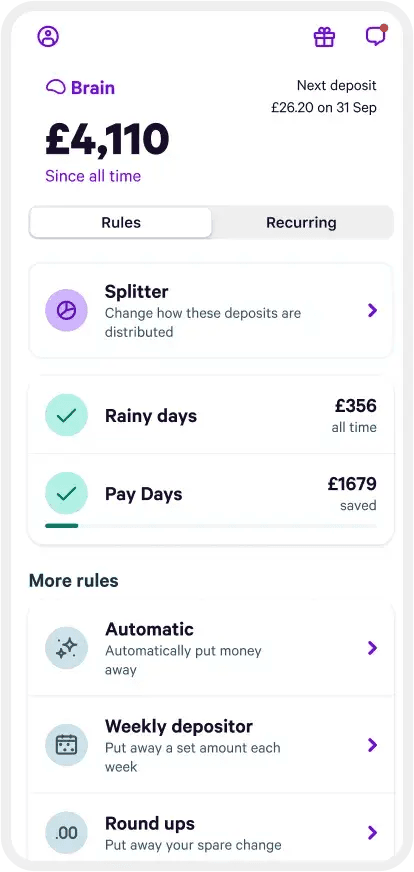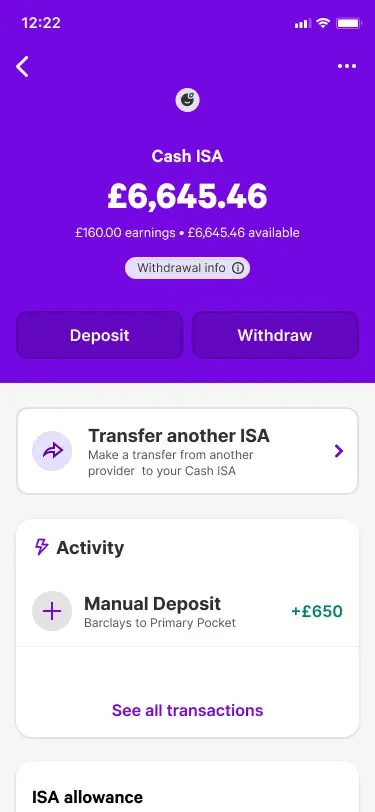All investing should be regarded as longer term. The value of your investments can go up and down, and you may get back less than you invest. Past performance is no guarantee of future results. If you’re not sure which investments are right for you, please seek out a financial adviser. Capital at risk.
Plum is a smart money management app designed to automatically set aside money without you even thinking about it. It was founded in 2016, and started as a Facebook Messenger chatbot. Plum then launched the app (available on Android and iOS) which is designed to make managing your money easy, but it’s also effective for those who struggle to put that bit extra away. And the basic version is free. It also has savings accounts that you can compare.

How does Plum work?
- Bank account access: Plum users give it access to their bank accounts in a read-only view using the latest biometric security measures.
- Plum adapts to you: Plum’s smart software analyses and understands patterns in your income and spending habits to recognise the most effective way for savings to be made.
- Auto-deposits: Once Plum calculates a suitable amount to be put aside each week, this amount is automatically transferred through direct debit into your Plum account to be held until you withdraw it.
- Notifications: The Plum app can send you notifications about the amounts you’ve put aside, daily or weekly balance updates, and bills you could switch to save money.
- Flexibility and accessibility: You can withdraw or deposit more money, keep a record of your deposited amount and even invest your savings directly through the app.
- Spending insights: Plum keeps you informed with customisable updates to monitor your account activity.
Investing with Plum
Plum also gives you the option to invest some, or all, of your deposited money. You can choose between a range of investment funds, kept in a stocks and shares ISA, a general investment account or a money market investment fund. You should consider carefully which of these portfolios (you can choose multiple) is best for you, depending on your expertise and risk appetite. You can start investing with just £1.
What can you invest in with Plum?
Through the Plum app, you can choose how much to invest in a range of investment funds, or automatically allocate a set percentage of your auto-deposits to go towards those funds. Examples of the investments funds available include “Tech Giants” (which includes shares of tech leaders such as Apple, Facebook and Google), or “Slow & Steady” (a mix of bonds and stocks).
Here are the portfolios available:
| Portfolio name | Types of investment | Risk |
|---|---|---|
| Tech Giants | Invest in technology shares | 6/7 |
| Clean and Green | Invest in companies selected for their social responsibility | 5/7 |
| Rising Stars | Invest in the growth of new giants in Asia and Africa | 6/7 |
| The Medic | Invest in shares of healthcare, pharmaceuticals and biotechnology companies | 6/7 |
| Balanced Ethical | A mix of assets based on their environmental, social and governance (ESG) criteria | 5/7 |
| Growth ethical | Invest in global companies selected for their environmental, social and governance (ESG) track record | 5/7 |
| American Dream | Invest in US company shares that tracks the performance of the S&P total market index | 5/7 |
| Best of British | Invest in the 100 largest public companies in the UK | 5/7 |
| European Essentials | Invest in large and mid-sized companies in developed markets in Europe. | 5/7 |
| Slow and Steady | 20% shares and 80% bonds. This fund expects to get moderate returns and is better protected from losses. | 3/7 |
| Balanced Bundle | 60% shares and 40% bonds. This fund has a balanced combination of shares and bonds. | 4/7 |
| Growth Stack | 80% shares and 20% bonds. This fund has high potential returns but is higher risk. | 5/7 |
How do I withdraw my Plum investments?
In terms of withdrawals, you can withdraw your investments as often as you wish, although it can take up to 5 days for the money to return to your account.
If you do decide to invest, keep in mind that your capital is at risk and that you could get back less than you invested.
What investment accounts are available with Plum?
You can choose between 4 accounts:
- Plum ISA
- Plum general investment account
- Plum self invested personal pension
- Plum Interest (money market investment fund)
Plum also offers a cash ISA.
Plum general investment account
This account is a standard investment account. There aren’t any tax benefits, so people usually choose this one if they’ve used their ISA allowance already.
You can invest in the same portfolios as with the other accounts. You may be liable to pay tax on profits over £3,000 in each tax year.
Plum self invested personal pension
Plum also offers a SIPP, which lets you save up for your retirement. It’s designed to be automated and flexible. You can pay into your SIPP the same way as with its other products, and you can move existing pensions into your Plum SIPP.
The main benefit is that you can see all of your accounts in one place and invest in its wide range of funds. SIPP investors can choose from 6 funds designed for those investing for retirement.
Pensions can’t be cashed out until you turn 55, but you do get tax relief from the government, which Plum applies for on your behalf.
Plum ISA
With Plum’s ISA you can use your annual ISA allowance, which means that you can invest up to this amount each tax year without paying any tax on your profits. The allowance for the 2025/2026 tax year is £20,000.
Plum Interest
Launched in 2023, this is a low-risk money market investment fund that pays interest on your money and lets you withdraw cash by the next working day. Your money is invested in high-quality assets that generate interest.
Plum’s fees and limits
It’s free to start setting aside money with Plum. The free Plum Basic plan includes the app download and registration, as well as unlimited deposits and withdrawals, and the automatic deposit feature and bill analysis.
But there are fees for investing your money with Plum:
- Plum Interest fee. If you open this account, you’ll be charged 0.25%. This includes a 0.15% fee charged by Plum (waived if you’re a Premium customer), plus a 0.10% annual fund management fee charged by BlackRock.
- Investment fee. This is £2.99 per month (it’s the fee for using Plum Plus, the minimum plan you’ll need to subscribe to if you’d like to use Plum’s investment features).
- Fund manager and management fee. The fund manager fee is between 0.13% and 0.88% a year, depending on which fund you choose. Additionally, there is a annual management fee equal to 0.45% of the value of each of your ISA/GIA platform products.
- SIPP fees. This is also 0.45% a year. It’s broken down into 0.35% for the product provider administration fee and 0.10% for the custody service charge. There will also be a fund management fee.
As well as Plum Basic (free) and Plum Pro (£2.99 a month), there’s a third tier called Plum Premium, which costs £9.99 per month. As well as the investment features you get with Plum Pro, you can unlock additional functionalities, such as investing automatically and using the Plum debit card. We go into more detail about Plum Premium below.
Note that both paid plans offer a 30-day free trial.
What is Plum Premium?
This is the top Plum account tier, which costs £9.99 per month.
With Plum Premium, you’ll get all the functionality available with Plum Basic and Plum Pro, as well as the following features:
- Invest a fixed amount automatically – daily, weekly or monthly
- Get the Plum debit card – this is a preloaded Visa card to help you budget
- 95-day notice account – lock your money away with a 95-day notice period and get a better interest rate
- More savings rules – you can choose from 9 different Auto Savers to put money away automatically (Basic customers have 5 rules and Pro customers have 8)
- Lower annual fund provider fee – pay 0.15% instead of 0.45%
- Stock alerts – get alerted when a stock reaches a certain price
Both Plum Pro and Plum Premium also offer the Splitter feature which allows you to automatically divide your deposits between savings and investments.
Plum’s Easy Access Savings Pockets
Whichever plan you go for with Plum, you can open an Easy Access Savings ‘Pocket’ to store some of your cash. However, Basic customers will receive a lower interest rate on that cash compared to Pro and Premium customers, with Premium customers receiving the top rate. Basic and Pro customers can open one Easy Access Savings Pocket, while Premium customers can open up to 10.
What’s more, Pro and Premium customers have the option of assigning different savings goals for pockets. It’s easy to track your progress against these goals in the app.
Money set aside in Plum’s Pockets will be held on trust with the Investec banking group, which means these funds will be protected by the Financial Services Compensation Scheme.
Compare savings accounts from Plum
Compare other products
We currently don't have that product, but here are others to consider:
How we picked theseWhat is Plum’s “Naughty Rule” savings feature?
The “Naughty Rule” is a feature which automatically sets money aside every time you buy something from a retailer you consider a “guilty pleasure”. It’s only available with Plum Premium.
When you purchase something “naughty” from one of the specified retailers, Plum will automatically put aside a set amount into your savings. You can set the amount of money to be set aside, ranging from £1 (“Mildy Mischievous”) to £10 (“Very Villanous”).
Once the “Naughty Rule” has been fully enabled, Plum will make one extra saving per day when you spend at one of your chosen retailers.
Is Plum safe?
Apart from money deposited in Pockets, funds held in a general Plum account are not specifically covered by the Financial Services Compensation Scheme (which protects deposits of up to £120,000), as the company is not a licensed bank. But Plum is authorised and regulated by the FCA as an e-wallet money agent of Modulr, which allows it to provide users with an e-wallet. Customer funds are held in a pooled account at a UK bank chosen by Modulr and are protected by safeguarding rules.
Plum also considers its users’ safety and security a top priority – and here are some of the ways Plum works to keep you safe:
- Plum never stores, or accesses, your bank login details.
- Plum receives read-only access to your transaction data, so has very limited information.
- Plum only receives money through a direct debit, which you can cancel at any time.
- Plum uses symmetric cryptography (AES) to store any sensitive data.
- Plum uses state-of-the-art password algorithms.
- Plum uses 256-bit TLS encryption to communicate between the browser and its servers.
- Plum is a registered data controller and always acts in compliance with the Data Protection Act.
- Plum runs its servers on Amazon’s cloud, which is trusted by some of the biggest financial institutions in the world.
What does the Plum app look like?



How does Plum make money?
Plum was heavily funded through its startup phase by crowdfunding campaigns. However, now it’s established it looks to create its own revenue through two main revenue streams:
- Charging fees for its investment options (including its monthly subscription fees for Plum Plus and Plum Pro).
- Finding its customers better deals on their bills and getting an introductory fee for facilitating any switches.
Pros and cons of Plum
Pros
- Set aside your money easily and automatically.
- Free to register and use.
- Contact Plum easily through its Android and iOS app.
- Withdraw money 24/7 and receive it within 24 hours (and often, within 15 minutes).
- Money in your Plum account is held by Modulr, an EU-licensed e-money provider, which means the funds you have with Plum are safeguarded.
- Plum’s algorithm prevents auto-deposits taking you into your overdraft (unless you manually deposit money when you’re in your overdraft).
- Chance to grow your money by investing.
- Option to open an interest-paying Easy Access Savings Pocket.
Cons
- If you choose to invest with Plum, you need to remember that as always when investing, your capital is at risk.
- Customer funds are not protected by the Financial Services Compensation Scheme (apart from the money in Pockets, which is held on trust at the Investec banking group).
- Access to money isn’t instantaneous, it can take 24 hours.
- Plum does not provide phone support.
Plum and Finder Awards

Our Finder Awards celebrate brands that truly stand out in their field, creating innovative personal finance products and providing outstanding service to their customers. Plum is one of these brands and was named our 2024 Savings People's Choice Award winner!
Customer service information for Plum
| Email support | |
|---|---|
| Telephone support | |
| In-app or live chat | |
| Contact form | |
| Branch support |
Bottom line
Saving is not an especially fun task, and while we all want to be doing it, doing the actual maths and remembering to transfer the money every week or every month requires a lot of commitment. So why not have it done automatically by Plum?
It’s a very smart concept, although there are a few drawbacks to consider. The main one is that Plum’s general account does not pay any interest. So your money won’t be growing unless you open an Easy Access Pocket, a cash ISA, or you decide to invest your funds, which of course entails a whole different set of risks and issues. Get started by downloading the app.
Overall, Plum can be a smart and fun way to put money aside without doing much budgeting, or even having to go into your current account to manually make a transfer. Plum also offers Easy Access Savings Pockets, and has a good range of investing options, some of which are suitable for beginners.
Frequently asked questions
More guides on Finder
-
Is your money fit to fly?
Uphold is a digital asset platform with a multi-currency payment card. Their mission is to spotlight and solve some common money challenges from budgeting and saving to travel – and the age-old debate of whether anyone still uses cash anymore.
-
Kuda money app review
We take a detailed look at the Kuda money app to see how it works.
-
Snoop app review
The Snoop app promises to help you spend your money in a smarter way and show you how take advantage of the best deals out there.
-
Monzo statistics: Revenue, number of customers and market share
Valued at around £3.7 billion, and having 7.5 million customers, Monzo is a British startup success story.
-
Revolut statistics: Revenue, number of customers and market share
With 30 million customers worldwide and 38.2 million app downloads, Revolut is one of the most successful online banks.
-
Tally Money review
Tally is an innovative banking app that effectively uses gold as a currency. We’ve looked into how it works for you.
-
Best banks and bank accounts for travelling and spending abroad
Planning a trip abroad? Make sure you have a travel money card and app set up and ready to use abroad. Check out our guide to find the best one for you!
-
Chip savings app review
The Chip savings app will connect to your current account and stash money away automatically. We cover all you need to know about the innovative app in this review.
-
Atom bank review
Is Atom bank the right challenger bank for you? We explore the app and the features of Atom’s Fixed Saver accounts.
